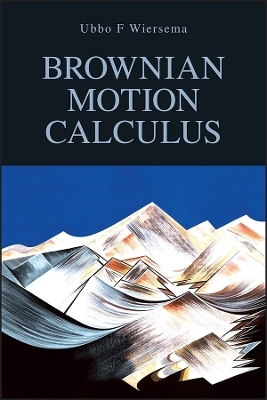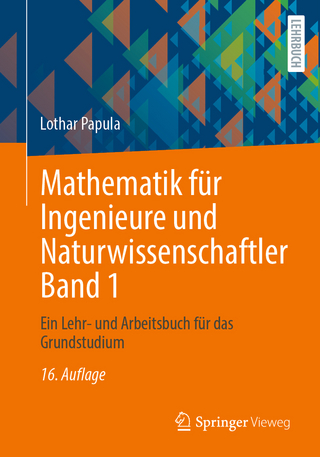
Brownian Motion Calculus
John Wiley & Sons Inc (Verlag)
978-0-470-02170-5 (ISBN)
BROWNIAN MOTION CALCULUS Brownian Motion Calculus presents the basics of Stochastic Calculus with a focus on the valuation of financial derivatives. It is intended as an accessible introduction to the technical literature. The sequence of chapters starts with a description of Brownian motion, the random process which serves as the basic driver of the irregular behaviour of financial quantities. That exposition is based on the easily understood discrete random walk. Thereafter the gains from trading in a random environment are formulated in a discrete-time setting. The continuous-time equivalent requires a new concept, the Itō stochastic integral. Its construction is explained step by step, using the so-called norm of a random process (its magnitude), of which a motivated exposition is given in an Annex. The next topic is Itō’s formula for evaluating stochastic integrals; it is the random process counter part of the well known Taylor formula for functions in ordinary calculus. Many examples are given. These ingredients are then used to formulate some well established models for the evolution of stock prices and interest rates, so-called stochastic differential equations, together with their solution methods. Once all that is in place, two methodologies for option valuation are presented. One uses the concept of a change of probability and the Girsanov transformation, which is at the core of financial mathematics. As this technique is often perceived as a magic trick, particular care has been taken to make the explanation elementary and to show numerous applications. The final chapter discusses how computations can be made more convenient by a suitable choice of the so-called numeraire. A clear distinction has been made between the mathematics that is convenient for a first introduction, and the more rigorous underpinnings which are best studied from the selected technical references. The inclusion of fully worked out exercises makes the book attractive for self study. Standard probability theory and ordinary calculus are the prerequisites. Summary slides for revision and teaching can be found on the book website www.wiley.com/go/brownianmotioncalculus.
UBBO WIERSEMA was educated in Applied Mathematics at Delft, in Operations Research at Berkeley, and in Financial Economics and Financial Mathematics at the London School of Economics. He joined The Business School for Financial Markets (the ICMA Centre) at the University of Reading, UK, in 1997, to develop and teach its curriculum in Quantitative Finance. Prior to that, he was a derivatives mathematician at the merchant bank Robert Fleming in the City of London. His earlier career was in Operations Research in the US and Europe.
Preface xiii
1 Brownian Motion 1
1.1 Origins 1
1.2 Brownian Motion Specification 2
1.3 Use of Brownian Motion in Stock Price Dynamics 4
1.4 Construction of Brownian Motion from a Symmetric Random Walk 6
1.5 Covariance of Brownian Motion 12
1.6 Correlated Brownian Motions 14
1.7 Successive Brownian Motion Increments 16
1.7.1 Numerical Illustration 17
1.8 Features of a Brownian Motion Path 19
1.8.1 Simulation of Brownian Motion Paths 19
1.8.2 Slope of Path 20
1.8.3 Non-Differentiability of Brownian Motion Path 21
1.8.4 Measuring Variability 24
1.9 Exercises 26
1.10 Summary 29
2 Martingales 31
2.1 Simple Example 31
2.2 Filtration 32
2.3 Conditional Expectation 33
2.3.1 General Properties 34
2.4 Martingale Description 36
2.4.1 Martingale Construction by Conditioning 36
2.5 Martingale Analysis Steps 37
2.6 Examples of Martingale Analysis 37
2.6.1 Sum of Independent Trials 37
2.6.2 Square of Sum of Independent Trials 38
2.6.3 Product of Independent Identical Trials 39
2.6.4 Random Process B(t) 39
2.6.5 Random Process exp[B(t) – t] 40
2.6.6 Frequently Used Expressions 40
2.7 Process of Independent Increments 41
2.8 Exercises 42
2.9 Summary 42
3 Itō Stochastic Integral 45
3.1 How a Stochastic Integral Arises 45
3.2 Stochastic Integral for Non-Random Step-Functions 47
3.3 Stochastic Integral for Non-Anticipating Random Step-Functions 49
3.4 Extension to Non-Anticipating General Random Integrands 52
3.5 Properties of an Itō Stochastic Integral 57
3.6 Significance of Integrand Position 59
3.7 Itō integral of Non-Random Integrand 61
3.8 Area under a Brownian Motion Path 62
3.9 Exercises 64
3.10 Summary 67
3.11 A Tribute to Kiyosi Itō 68
Acknowledgment 72
4 Itō Calculus 73
4.1 Stochastic Differential Notation 73
4.2 Taylor Expansion in Ordinary Calculus 74
4.3 Itō’s Formula as a Set of Rules 75
4.4 Illustrations of Itō’s Formula 78
4.4.1 Frequent Expressions for Functions of Two Processes 78
4.4.2 Function of Brownian Motion f [B(t)] 80
4.4.3 Function of Time and Brownian Motion f [t, B(t)]82
4.4.4 Finding an Expression for 83
4.4.5 Change of Numeraire 84
4.4.6 Deriving an Expectation via an ODE 85
4.5 Lévy Characterization of Brownian Motion 87
4.6 Combinations of Brownian Motions 89
4.7 Multiple Correlated Brownian Motions 92
4.8 Area under a Brownian Motion Path – Revisited 95
4.9 Justification of Itō’s Formula 96
4.10 Exercises 100
4.11 Summary 101
5 Stochastic Differential Equations 103
5.1 Structure of a Stochastic Differential Equation 103
5.2 Arithmetic Brownian Motion SDE 104
5.3 Geometric Brownian Motion SDE 105
5.4 Ornstein–Uhlenbeck SDE 108
5.5 Mean-Reversion SDE 110
5.6 Mean-Reversion with Square-Root Diffusion SDE 112
5.7 Expected Value of Square-Root Diffusion Process 112
5.8 Coupled SDEs 114
5.9 Checking the Solution of a SDE 115
5.10 General Solution Methods for Linear SDEs 115
5.11 Martingale Representation 120
5.12 Exercises 123
5.13 Summary 124
6 Option Valuation 127
6.1 Partial Differential Equation Method 128
6.2 Martingale Method in One-Period Binomial Framework 130
6.3 Martingale Method in Continuous-Time Framework 135
6.4 Overview of Risk-Neutral Method 138
6.5 Martingale Method Valuation of Some European Options 139
6.5.1 Digital Call 139
6.5.2 Asset-or-Nothing Call 141
6.5.3 Standard European Call 142
6.6 Links between Methods 144
6.6.1 Feynman-Kač Link between PDE Method and Martingale Method 144
6.6.2 Multi-Period Binomial Link to Continuous 146
6.7 Exercise 147
6.8 Summary 148
7 Change of Probability 151
7.1 Change of Discrete Probability Mass 151
7.2 Change of Normal Density 153
7.3 Change of Brownian Motion 154
7.4 Girsanov Transformation 155
7.5 Use in Stock Price Dynamics – Revisited 160
7.6 General Drift Change 162
7.7 Use in Importance Sampling 163
7.8 Use in Deriving Conditional Expectations 167
7.9 Concept of Change of Probability 172
7.9.1 Relationship between Expected Values under Equivalent Probabilities 174
7.10 Exercises 174
7.11 Summary 176
8 Numeraire 179
8.1 Change of Numeraire 179
8.1.1 In Discrete Time 179
8.1.2 In Continuous Time 182
8.2 Forward Price Dynamics 184
8.2.1 Dynamics of Forward Price of a Bond 184
8.2.2 Dynamics of Forward Price of any Traded Asset 185
8.3 Option Valuation under most Suitable Numeraire 187
8.3.1 Exchange Option 187
8.3.2 Option on Bond 188
8.3.3 European Call under Stochastic Interest Rate 188
8.4 Relating Change of Numeraire to Change of Probability 190
8.5 Change of Numeraire for Geometric Brownian Motion 192
8.6 Change of Numeraire in LIBOR Market Model 194
8.7 Application in Credit Risk Modelling 198
8.8 Exercises 200
8.9 Summary 201
Annexes
A Annex A: Computations with Brownian Motion 205
A. 1 Moment Generating Function and Moments of Brownian Motion 205
A. 2 Probability of Brownian Motion Position 208
A. 3 Brownian Motion Reflected at the Origin 208
A. 4 First Passage of a Barrier 214
A. 5 Alternative Brownian Motion Specification 216
B Annex B: Ordinary Integration 221
B. 1 Riemann Integral 221
B. 2 Riemann–Stieltjes Integral 226
B. 3 Other Useful Properties 231
B. 4 References 234
C Annex C: Brownian Motion Variability 235
C. 1 Quadratic Variation 235
C. 2 First Variation 238
D Annex D: Norms 239
D. 1 Distance between Points 239
D. 2 Norm of a Function 242
D. 3 Norm of a Random Variable 244
D. 4 Norm of a Random Process 244
D. 5 Reference 246
E Annex E: Convergence Concepts 247
E. 1 Central Limit Theorem 247
E. 2 Mean-Square Convergence 248
E. 3 Almost Sure Convergence 249
E. 4 Convergence in Probability 250
E. 5 Summary 250
Answers to Exercises 253
References 299
Index 303
| Verlagsort | New York |
|---|---|
| Sprache | englisch |
| Maße | 153 x 227 mm |
| Gewicht | 510 g |
| Themenwelt | Mathematik / Informatik ► Mathematik ► Angewandte Mathematik |
| Naturwissenschaften ► Physik / Astronomie ► Thermodynamik | |
| Wirtschaft ► Betriebswirtschaft / Management | |
| ISBN-10 | 0-470-02170-5 / 0470021705 |
| ISBN-13 | 978-0-470-02170-5 / 9780470021705 |
| Zustand | Neuware |
| Informationen gemäß Produktsicherheitsverordnung (GPSR) | |
| Haben Sie eine Frage zum Produkt? |
aus dem Bereich


